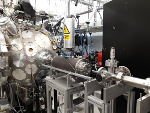| | 51 | |
| | 52 | |
| | 53 | === Notes from IPAC19 === |
| | 54 | ''by Christopher Hunt'' |
| | 55 | |
| | 56 | Due to clashes, issues with the papers etc, I didn't manage to attend a lot in person, however these are some observations from what was available and a few conversation. |
| | 57 | |
| | 58 | Found two of the biggest players, ELI and CLAPA (its likely that I missed some of the other big names). Both have similar ideas: laser-target produced protons with some conventional magnet based capture and delivery system, both targeting radiobiological research. |
| | 59 | |
| | 60 | ELI: |
| | 61 | * Prague institute |
| | 62 | * Expect first beams by the end of the year |
| | 63 | * They have designs for a cryogenic H2 target, basically extruding liquid hydrogen into the target area. It wasn't obvious how advanced the designs were |
| | 64 | * Conventional focussing |
| | 65 | * Use a reasonably big laser with plans to upgrade in the next few years (>1 Petawatt) |
| | 66 | |
| | 67 | CLAPA: |
| | 68 | * Peking University |
| | 69 | * Publicized results already, |
| | 70 | * Very large laser (I think Petawatt class), with planned upgrades |
| | 71 | * Uses conventional focussing, maybe quadrupole capture, |
| | 72 | * Claim very high stability and high energy beams |
| | 73 | * Really seem like they are ahead in the game |
| | 74 | |
| | 75 | Observed some comments on polarised beams to improve performance of laser-target interactions - not sure what the logic is? |
| | 76 | |
| | 77 | General consensus is to just use a bigger laser and conventional capture/focussing. I got the impression that shop-bought petawatt-class laser was the starting point for several groups. |
| | 78 | |
| | 79 | There were no mentions of high-current proton cyclotrons that I could find |
| | 80 | |
| | 81 | I found one poster discussing a flash-dose electron cyclotron, |
| | 82 | |
| | 83 | Found rapid-cycling synchrotron design with reasonable footprint (20mx10m) producing 250MeV beam. Due to the size of laser systems, this is probably the same footprint as a laser-target facility. |
| | 84 | |
| | 85 | Couple of 200+MeV proton cyclotrons in the works, but these are low-current machines |
| | 86 | |
